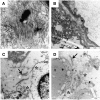Oxidative stress in preeclampsia and the role of free fetal hemoglobin
- PMID: 25628568
- PMCID: PMC4292435
- DOI: 10.3389/fphys.2014.00516
Oxidative stress in preeclampsia and the role of free fetal hemoglobin
Abstract
Preeclampsia is a leading cause of pregnancy complications and affects 3-7% of pregnant women. This review summarizes the current knowledge of a new potential etiology of the disease, with a special focus on hemoglobin-induced oxidative stress. Furthermore, we also suggest hemoglobin as a potential target for therapy. Gene and protein profiling studies have shown increased expression and accumulation of free fetal hemoglobin in the preeclamptic placenta. Predominantly due to oxidative damage to the placental barrier, fetal hemoglobin leaks over to the maternal circulation. Free hemoglobin and its metabolites are toxic in several ways; (a) ferrous hemoglobin (Fe(2+)) binds strongly to the vasodilator nitric oxide (NO) and reduces the availability of free NO, which results in vasoconstriction, (b) hemoglobin (Fe(2+)) with bound oxygen spontaneously generates free oxygen radicals, and (c) the heme groups create an inflammatory response by inducing activation of neutrophils and cytokine production. The endogenous protein α1-microglobulin, with radical and heme binding properties, has shown both ex vivo and in vivo to have the ability to counteract free hemoglobin-induced placental and kidney damage. Oxidative stress in general, and more specifically fetal hemoglobin-induced oxidative stress, could play a key role in the pathology of preeclampsia seen both in the placenta and ultimately in the maternal endothelium.
Keywords: alpha-1-microglobulin; fetal hemoglobin; hemolysis; oxidative stress; placenta.
Figures




Similar articles
-
Increased levels of cell-free hemoglobin, oxidation markers, and the antioxidative heme scavenger alpha(1)-microglobulin in preeclampsia.Free Radic Biol Med. 2010 Jan 15;48(2):284-91. doi: 10.1016/j.freeradbiomed.2009.10.052. Epub 2009 Oct 30. Free Radic Biol Med. 2010. PMID: 19879940
-
Fetal hemoglobin in preeclampsia: a new causative factor, a tool for prediction/diagnosis and a potential target for therapy.Curr Opin Obstet Gynecol. 2013 Dec;25(6):448-55. doi: 10.1097/GCO.0000000000000022. Curr Opin Obstet Gynecol. 2013. PMID: 24185004 Review.
-
A1M Ameliorates Preeclampsia-Like Symptoms in Placenta and Kidney Induced by Cell-Free Fetal Hemoglobin in Rabbit.PLoS One. 2015 May 8;10(5):e0125499. doi: 10.1371/journal.pone.0125499. eCollection 2015. PLoS One. 2015. PMID: 25955715 Free PMC article.
-
Hypothesis: selective phosphodiesterase-5 inhibition improves outcome in preeclampsia.Med Hypotheses. 2004;63(6):1057-64. doi: 10.1016/j.mehy.2004.03.042. Med Hypotheses. 2004. PMID: 15504576
-
The role of hemoglobin degradation pathway in preeclampsia: A systematic review and meta-analysis.Placenta. 2020 Mar;92:9-16. doi: 10.1016/j.placenta.2020.01.014. Epub 2020 Jan 27. Placenta. 2020. PMID: 32056786
Cited by
-
Transport of Biologically Active Ultrashort Peptides Using POT and LAT Carriers.Int J Mol Sci. 2022 Jul 13;23(14):7733. doi: 10.3390/ijms23147733. Int J Mol Sci. 2022. PMID: 35887081 Free PMC article. Review.
-
Hematological and biochemical alterations in preeclampsia: Readings from cord blood analysis.PLoS One. 2025 May 30;20(5):e0324460. doi: 10.1371/journal.pone.0324460. eCollection 2025. PLoS One. 2025. PMID: 40446190 Free PMC article.
-
Oxidative stress promotes cellular damages in the cervix: implications for normal and pathologic cervical function in human pregnancy†.Biol Reprod. 2021 Jul 2;105(1):204-216. doi: 10.1093/biolre/ioab058. Biol Reprod. 2021. PMID: 33760067 Free PMC article.
-
Phenolic Melatonin-Related Compounds: Their Role as Chemical Protectors against Oxidative Stress.Molecules. 2016 Oct 29;21(11):1442. doi: 10.3390/molecules21111442. Molecules. 2016. PMID: 27801875 Free PMC article. Review.
-
Dopamine in the Pathophysiology of Preeclampsia and Gestational Hypertension: Monoamine Oxidase (MAO) and Catechol-O-methyl Transferase (COMT) as Possible Mechanisms.Oxid Med Cell Longev. 2019 Nov 28;2019:3546294. doi: 10.1155/2019/3546294. eCollection 2019. Oxid Med Cell Longev. 2019. PMID: 31871546 Free PMC article. Review.
References
Publication types
LinkOut - more resources
Full Text Sources
Other Literature Sources
Medical

